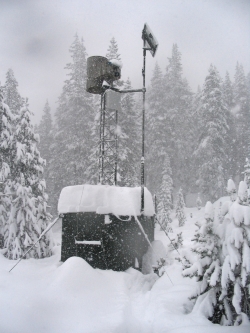
Silver Iodide is burned using a ice nucleus generator. Courtesy of CWCB
Think Mother Nature is the only one that can control the weather? Well think again. During times of drought and as we look toward an uncertain climate future, water managers and scientists are relying on cloud seeding to bring snow to ski resorts and a more reliable water supply along the Colorado River. Cloud seeding is increasingly popular in southwestern Colorado as a way of making snow as it’s becoming more accurate and less of a gamble thanks to research and weather data collection. However, with data comes accuracy, and there is still a need for more data.
Cloud seeding is used as a way to boost the amount of snow falling in the winter as well as the amount of runoff in the spring by increasing moisture levels in the clouds. The Colorado Water Conservation Board (CWCB) has agreements with water providers and states throughout the Colorado River Basin, including the Southern Nevada Water Authority, Central Arizona Water Conservation District, the California Six Agency Committee, and the New Mexico Interstate Stream Commission. These agreements provide funding for cloud seeding in Colorado’s mountains to encourage hearty snowpack and ample water to flow out of state and downstream. The goal for the lower basin states is to increase water levels at Lake Mead as climate change may present some unknown challenges in the years to come. Many organizations in the southwestern United States have money tied up in seeding programs and rely on the extra 3-4 percent of Colorado River water for drinking and agricultural use. Ski resorts seed simply because they need the snow for their business. No snow, no skiers, no revenue. Those businesses and funding look to data to optimize the results of their cloud seeding efforts. If done at the wrong time or place, it will not be successful and thousands of dollars will dissipate into the Colorado sky
Cloud seeding, a method of weather modification, works like this: vaporized silver iodide is sent up into the clouds from a ground-based generator. The silver iodide forms an artificial nuclei that attracts water to form snowflakes. Then, the cloud releases the excess water over the desired region. According to Ken Curtis with the Dolores Water Conservancy District, the optimal location to start the cloud seeding generator is anywhere from five to 15 miles away and takes about 30 minutes for the snow to form and fall.
“It depends on storm and radar coverage to pick up on moisture,” Curtis says. Data plays a large part in deciding where to seed and whether or not it will be successful. Seeders use high resolution models to collect data on temperature, elevation and weather forecasting to know when and where to seed. A 10-year cloud seeding study out of Wyoming suggests that there is a potential for a 5-15 percent increase in precipitation. However, not all storms are the same and only about 30 percent of storms meet the criteria for seeding.
Joe Busto, the Colorado Water Conservation Board’s weather modification specialist, says that cloud seeding will have different results in different areas. “In Gunnison it is simply too cold to seed, but in Steamboat Springs the conditions are much more favorable for seeding.” Since every location is different, it is necessary to have data specific to your location and conditions in order to know if seeding is appropriate.
Scientists use four pieces of equipment to collect data for cloud seeding:
- High resolution weather research forecast model
- Model graphs and displays to show the conditions
- Forecast soundings
- Radiometer
The high resolution weather research forecast model provides information about when to expect a storm in the area. The graphs and displays provide data about wind speed and direction, height, temperature and precipitation totals. A forecast sounding is a digital version of a weather balloon and simulates a weather balloon launch. In Colorado, the National Weather Service launches weather balloons twice a day in Grand Junction and Denver. Forecast soundings provide data for 119 locations in Colorado. The radiometer is used to collect atmospheric data every five minutes. In addition to these pieces of equipment, Winter Park uses a ceilometer. It sits on top of a parking garage in the town and produces data about cloud density and height by sending a laser high into the atmosphere.
Even with all this data and instrumentation, there is still uncertainty involved in cloud seeding. Although data is important in seeding, it doesn’t mean that having accurate data is a 100 percent guarantee of success—there’s still some guess work involved . Cloud seeding has proven useful in providing an increase in snowfall for ski resorts and in providing additional runoff flows in the spring, and many businesses, water providers and state governments are financially betting on it, but there’s no guaranty of success.

 Print
Print
Reblogged this on Coyote Gulch.
Can ceilometers be used in weather engineering?